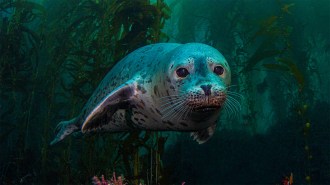Another World Hides inside Coral Reefs
Specialized video equipment snaked into small crevices in coral reefs of the Red

Sea has revealed a community that rivals the one visible outside.
“The largest habitat is inside,” contends Claudio Richter of the Center for
Tropical Marine Ecology in Bremen, Germany.
For each square meter of ocean bottom covered by the reefs, cavities inside offer
2.4 to 7.5 m&³2; of surface area, Richter and his colleagues calculate. Sponges make
up some 60 percent of that hidden community, capturing small plankton that otherwise would wash away. “The internal part of the reef feeds the outside,”
Richter says.
He explains that scientists have explored caves in reefs but could only guess what lay beyond small fissures. Now, an underwater endoscopic video system developed by
Mark Wunsch, also at Bremen, has allowed the team of Arab, Israeli, and German scientists to probe 4 m into crevices. In the Oct. 18 Nature, the team reports the
first systematic survey of reef innards.
“Our main message to the scientific community is that there is much more in the
reef than what you see on the outside,” Richter says.
Reef biologist Nancy Knowlton of Scripps Institution of Oceanography in La Jolla,
Calif., compares the research team’s work to the early revelations of forest
canopy richness. The endoscopic survey “gives you a whole new feeling for what a
reef is,” she says.
The survey team explored crevices at nine sites off Egypt, Israel, and Jordan.
Cavities, typically with an opening only 20 centimeters wide, riddle up to 40
percent of the area sampled.
The team worked out the shape and size of crevices by inserting a device that cast
a slim hoop of light onto the bumpy interior. As the device advanced, the team
recorded the series of irregular light rings. A computer analysis stacked the
rings to recreate the cavity.
Beyond the zone near the mouth of a cavity which receives some light, sponges with
sheetlike forms covered half to two-thirds of the inside area. In water samples
that had flowed over the sponges, signs of micron-scale organisms called
picoplankton diminished and mineral concentrations increased. “These guys are
eating a lot, and they’re excreting a lot,” Richter says.
He proposes that the abundant sponges inside the reef capture small ocean life,
such as cyanobacteria, that the external reef species don’t use efficiently. Such
industrious interior feeders could explain what Richter describes as the plankton
gap, a long-recognized drop in plankton concentrations around reefs even though
the visible organisms don’t seem to be trapping many of them.
The minerals that sponges excrete could provide much nitrogen and other nutrients
for other reef organisms, Richter says. He proposes that such a bonus might
explain the so-called Darwin’s paradox, which asks how reefs can thrive in
nutrient-poor waters.
Reef ecologist Richard Grigg of the University of Hawaii at Manoa remains
skeptical on that speculation. As a former world-champion surfer, he maintains an
interest in wave action. He predicts that researchers studying reefs in water more
turbulent than the Red Sea will find fewer cavities–and fewer internal
communities. Yet reefs thrive under thundering waves.
Richter says he’s eager to see what the inside of the rest of the reef world looks
like and is already arranging surveys in the Caribbean.






